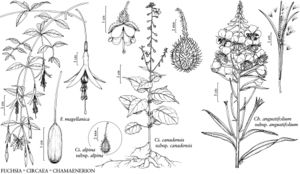Circaea alpina subsp. alpina
Stems soft, flattened after pressing and appearing winged, glabrous. Leaves: petiole 0.3–4 cm; blade 1.5–7.5 × 1.5–5.5 cm, margins conspicuously dentate, base usually cordate to subcordate, rarely truncate or rounded, apex short acuminate to acute. Inflorescences glabrous or sparsely to densely glandular puberulent. Flowers clustered at apex of raceme, opening before elongation of raceme axis; floral-tube a mere constriction between ovary and base of sepals to 0.5 mm; apical notch of petal 1/4–1/2 length of petal; pedicel and mature fruit combined length 3.7–6.5 mm. 2n = 22.
Phenology: Flowering summer.
Habitat: Moist to wet places, on moss covered rocks and logs, cool, temperate and boreal forests.
Elevation: 0–2500 m.
Distribution
Moist to wet places, on moss covered rocks and logs, cool, temperate and boreal forests, St. Pierre and Miquelon, Alta., B.C., Man., N.B., Nfld. and Labr. (Nfld.), N.W.T., N.S., Ont., P.E.I., Que., Sask., Yukon, Ariz., Colo., Conn., D.C., Idaho, Ill., Ind., Iowa, Ky., Maine, Md., Mass., Mich., Minn., Miss., Mo., Mont., N.H., N.J., N.Mex., N.Y., N.C., N.Dak., Ohio, Pa., R.I., S.C., S.Dak., Tenn., Vt., Va., Wash., W.Va., Wis., Wyo.
Discussion
Selected References
None.
